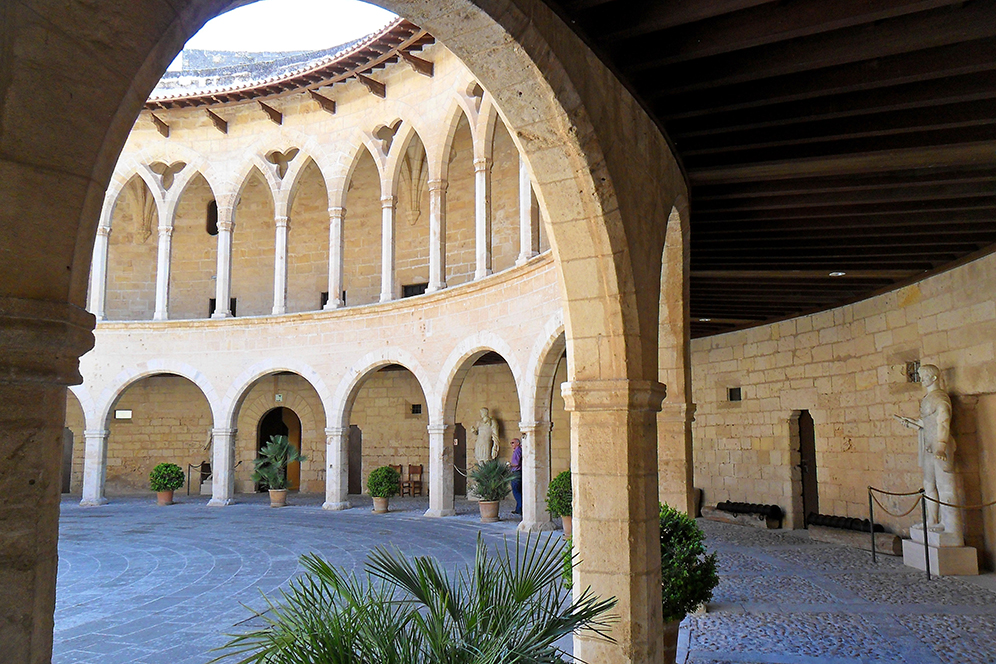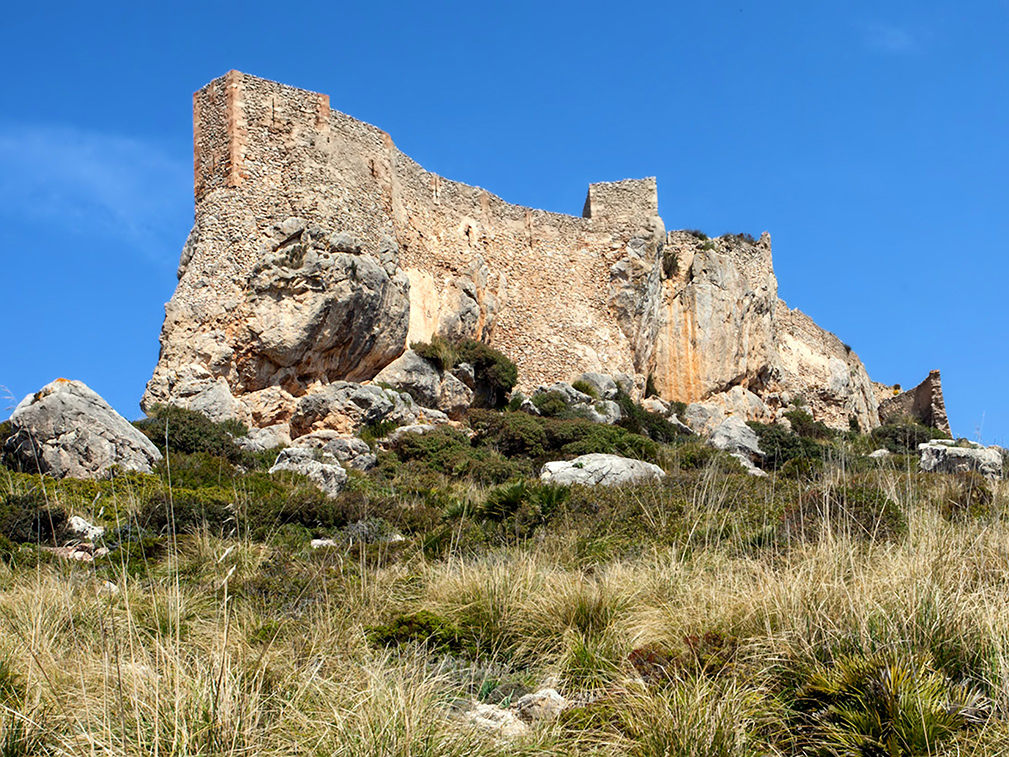
Mallorca is mostly known as a sun and beach island, but as many already know, it’s much more than just that. As a strategic point in the Mediterranean, Mallorca has a moved history with lots of conquers, reconquers and battles between different villages and tribes. The castles we find on the island are the voiceless stone witnesses of these events, many from different eras and each one of them with a fascinating story. Each and one of these castles are worth a visit, that’s why we would like to give you a mini tour to some of these castles in this blog entry.
We shall start our mini tour with which is probably the most famous castle on the island, Bellver Castle, located at about 3 kilometres from the centre of Palma de Mallorca at a height of 112, 6 m. It doesn’t only stand out due to its location being able to see it from most points of the Balearic city, but because it’s the only designed defence construction with a complete circular shape in the whole of Europe by the architect Pere Salvà, who already had redesigned the Royal Palace of La Almudaina. From the outside it is an almost unconquerable masterpiece of defense, while in the inside, where the patio is, the two floors have Roman and Gothic styles. Overall, there’s four towers from which three are part of the circular construction, while the fourth one is accessible by a small bridge. This tower offers views to the centre of the island, which gives the name to the castle for its “bella vista” (“beautiful views”). After having served as King’s Jaume II residence, it was used as a prison, throwing the prisoners into a cave of five meters below the fourth tower, the Tower of l'Homenatje. Where today there is a museum inside.
Now we shall transport ourselves to the west-south side of the island where we will find the Castell de Bendinat. One of the theories relating to the name of the locality of Bendinat, located in the municipality of Calvià, is that king Jaume I camped out here and after having a bread, garlic and olive soup said “Hem ben dinat”, which means “We have eaten well”. Even though it’s more probable that it comes from the Arabs such as the names of the villages of Binissalem, Binifaldó, etc. As the old estate wasn’t proper enough for him, the Roman Marquess in the 19th century built the Castell de Bendinat in a gothic style, following the style of other European castles. Today it belongs to the Foundation Astroc that organizes cultural activities, especially artistic expositions in the old possession.
Time to travel into the heart of the island where the most fortified castle is located. The Castell d’Alaró at 815 m of altitude dominates the town from the top of the hill of Alaró. It’s one out of the three rocky castles of Mallorca that served as defence and protection of the island; the other two are in Pollensa (Castell del Rei) and Felanitx (Castell de Santueri). In AD 905 it was mentioned for the first time as a construction for military service, who knows, in an Arab chronicle, but from other sources we know that there were already buildings in the area from the Bronze Age and the Romans. The Arab chronic says that the caste could not be conquered until the inhabitants of the castle exhausted their food and surrendered. This opinion is due to the fact that after the Muslim invasion there were a few refugees who resisted the enemy in the Castle of Alaró during eight and a half years. As well as it served as a refuge for the Christians, at the time of the Catalan conquest it was a refuge for the same Muslims. On top of the castle, of which there is only remaining’s like the castle walls and five towers, there’s the chapel of la Nostra Senyora del Refugi. To this one, hikers that walk along the route GR 221, and other visitors, can lodge and enjoy unbeatable landscapes over the heart of Mallorca.
From the south of the island we are going to travel to the north, where close to Pollensa, more specific in the valley of Ternelles, we find the castle in the far north corner of Mallorca. The Castell del Rei (King’s Castle) at a height of 492meters, about a three hour walk from the heart of the town. Together with the castles of Alaró and Felanitx it’s one of the three rocky castles on the island. Already back in the roman times it worked as a small stronghold, but in general it served more like a watchtower. However, repeatedly people sought refuge here: During the Catalan conquest, it was a refuge for the Muslims, as well as the Castell d’Alaró; and after the victory of the King of Aragon over Jaume III, king of Mallorca, it was the last resistance of the loyal to the Mallorcan king. From the 18th century, in which it was abandoned, the castle slowly went deteriorating, until today when there are only ruins left. In 1896 the Pollencí poet Miquel Costa I Llobera wrote a poem in the castles honour written in his dialect “U castell d’U rei”. Currently, the castle stands on a private estate needing to apply for permission at the town hall in Pollensa to get access.

At the opposite side, in the northeast, we find the Castle de Capdepera which are the ruins of a fortified village. It’s probably the Castle that hides most history, which you can still feel inside the walls and well preserved buildings. Located next to the village of Capdepera at the top of the hill, the castle was built on top of a Muslim village in the 14th century by King Jaume II. The only thing that remained of the old town was the tower, the Tower d'en Miquel Nunis that previously had already given birth to one of the most important events for the Balearic Archipelago of the Medieval age: It was when the caliph that reigned in Menorca signed a contract with the Mallorcan king, Jaume I, reassuring him to be submissive and deliver tributes. Until the 17th century more and more people from the neighboring regions sought refuge in the castle, due to continuous attacks and robberies by Turkish pirates. But from the beginning of the 18th century, with the Bourbons taking over the Spanish crown, the castle went turning into a little military base, making administrative problems between military and civilians. In 1983 the castle was given to the citizens of Capdepera, making today the fortress a small museum with an exhibition and the main place for the Medieval Fair of Capdepera that is celebrated annually.
We have got to the end of the tour, and we are going to end it with the third castle out of the three rocky castles on the island, the Castell de Santueri (Santueri Castle), in the municipality of Felanitx close to Manacor, this castle is surely one of the most spectacular ones thanks to its location above the meseta of Puig de Santueri with 423 m over sea level, making the castle impregnable. It is very possible that the area was already populated during the Talayotic period and probably served as a place of worship. Today’s ruins come from the 14th century medieval age, although they were built over the Muslim ruins which were probably also built over the Byzantine and Roman times ruins. The most striking of this castle are undoubtedly the walls that are adapted to the cliffs, in a way that there is no space left between the cliffs and the walls. During the Revolt of the Brotherhoods it was a site of resistance remaining loyal to the Crown, after that, it almost fell in disuse except for a little maintenance against possible attacks coming in from the sea. In the present, you can visit the castle with guides and enjoy amazing views overlooking the whole southeast of the island of Mallorca, even views to Menorca on a clear day.
Sadly, we have no castles for sale, but there is something we do have, and that’s more than one property that would make you feel like royalty, following the motto: “My home is my castle”.
Don’t hesitate to get in contact with us if you want to know more about our properties for sale in Mallorca.